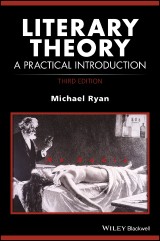Details
Literary Theory
A Practical IntroductionHow to Study Literature 3. Aufl.
|
23,50 € |
|
| Verlag: | Wiley-Blackwell |
| Format: | EPUB |
| Veröffentl.: | 17.01.2017 |
| ISBN/EAN: | 9781119061748 |
| Sprache: | englisch |
| Anzahl Seiten: | 304 |
DRM-geschütztes eBook, Sie benötigen z.B. Adobe Digital Editions und eine Adobe ID zum Lesen.
Beschreibungen
<i>Literary Theory: A Practical Introduction, Third Edition,</i> presents a comprehensive introduction to the<br />full range of contemporary approaches to the study of literature and culture, from formalism, structuralism, and historicism to ethnic, gender, and science studies.<br /><br />Introduces students to a variety of contemporary approaches to the study of literature and culture<br /><br />Demonstrates how the varying perspectives on texts can lead to different interpretations of the same work<br /><br />Features numerous updates that include new literary texts, new and expanded sections<br /><br />Represents the ideal accompaniment to the upcoming Third Edition of <i>Literary<br />Theory: An Anthology</i><br /><br />
<p>Note to Teachers x</p> <p>Literary Theory: A Primer 1</p> <p><b>Chapter 1 Russian Formalism, New Criticism, Poetics 20</b></p> <p>An Introduction to Russian Formalism, New Criticism, Poetics 20</p> <p>Exercise 1.1 William Shakespeare, King Lear 23</p> <p>Exercise 1.2 Elizabeth Bishop, “The Moose” and “At the Fishhouses” 27</p> <p>Exercise 1.3 F. Scott Fitzgerald, The Great Gatsby 39</p> <p>Exercise 1.4 Alice Munro, “Royal Beatings” and “Wild Swans” 42</p> <p>Exercise 1.5 The Wachowskis, The Matrix 44</p> <p><b>Chapter 2 Structuralism, Linguistics, Narratology 48</b></p> <p>An Introduction to Structuralism 48</p> <p>Exercise 2.1 William Shakespeare, King Lear 58</p> <p>Exercise 2.2 Elizabeth Bishop, “The Map” 60</p> <p>Exercise 2.3 F. Scott Fitzgerald, The Great Gatsby 61</p> <p>Exercise 2.4 Alice Munro, “The Progress of Love” 64</p> <p>Exercise 2.5 John Ford, The Searchers 66</p> <p><b>Chapter 3 Phenomenology, Reception, Ethics 69</b></p> <p>An Introduction to Phenomenology, Reception, Ethics 69</p> <p>Exercise 3.1 William Shakespeare, King Lear 72</p> <p>Exercise 3.2 Elizabeth Bishop, “The Fish” 74</p> <p>Exercise 3.3 F. Scott Fitzgerald, The Great Gatsby 74</p> <p>Exercise 3.4 Alice Munro, “Material” 77</p> <p>Exercise 3.5 Paul Gilroy, Michael Clayton 78</p> <p><b>Chapter 4 Post-Structuralism 80</b></p> <p>An Introduction to Post-Structuralism 80</p> <p>Exercise 4.1 William Shakespeare, King Lear 88</p> <p>Exercise 4.2 Elizabeth Bishop, “Over 2,000 Illustrations and a Complete Concordance” 98</p> <p>Exercise 4.3 F. Scott Fitzgerald, The Great Gatsby 101</p> <p>Exercise 4.4 Alice Munro, “Differently” 105</p> <p>Exercise 4.5 Alfred Hitchcock, The Birds and Tom Tykwer, Run, Lola, Run 109</p> <p><b>Chapter 5 Psychoanalysis and Psychology 113</b></p> <p>An Introduction to Psychoanalysis and Psychology 113</p> <p>Exercise 5.1 William Shakespeare, King Lear 120</p> <p>Exercise 5.2 Elizabeth Bishop, “Sestina” and “In the Village” 123</p> <p>Exercise 5.3 F. Scott Fitzgerald, The Great Gatsby 126</p> <p>Exercise 5.4 Alice Munro, “Meneseteung” 127</p> <p>Exercise 5.5 David Lynch, Blue Velvet 131</p> <p><b>Chapter 6 Marxism and Critical Theory 134</b></p> <p>An Introduction to Marxism and Critical Theory 134</p> <p>Exercise 6.1 William Shakespeare, King Lear 139</p> <p>Exercise 6.2 Elizabeth Bishop, “A Miracle for Breakfast” 142</p> <p>Exercise 6.3 F. Scott Fitzgerald, The Great Gatsby 142</p> <p>Exercise 6.4 Alice Munro, “Hired Girl” and “The Beggar Maid” 144</p> <p>Exercise 6.5 Mike Nichols, Working Girl and Stanley Kubrick, The Shining 147</p> <p><b>Chapter 7 History 153</b></p> <p>An Introduction to Historical Criticism 153</p> <p>Exercise 7.1 William Shakespeare, King Lear 155</p> <p>Exercise 7.2 Mary Shelley, Frankenstein 163</p> <p>Exercise 7.3 F. Scott Fitzgerald, The Great Gatsby 164</p> <p>Exercise 7.4 Alice Munro, “Walker Brothers Cowboy” 166</p> <p>Exercise 7.5 Elizabeth Bishop, “Twelve O’Clock News” 167</p> <p>Exercise 7.6 Luis Puenzo, The Official Story and Susana Blaustein Munoz and Lourdes Portillo, Las Madres de la Plaza de Mayo 168</p> <p><b>Chapter 8 Gender Studies 172</b></p> <p>An Introduction to Gender Studies 172</p> <p>Exercise 8.1 William Shakespeare, King Lear 177</p> <p>Exercise 8.2 Elizabeth Bishop, “Roosters,” “In the Waiting Room,” and “Exchanging Hats” 185</p> <p>Exercise 8.3 F. Scott Fitzgerald, The Great Gatsby 189</p> <p>Exercise 8.4 Alice Munro, “The Love of a Good Woman” and “Lichen” 190</p> <p>Exercise 8.5 Jonathan Demme, The Silence of the Lambs and Jenny Livingstone, Paris Is Burning 192</p> <p><b>Chapter 9 Ethnic Studies 198</b></p> <p>An Introduction to Ethnic Studies 198</p> <p>Exercise 9.1 Elizabeth Bishop, “Faustina, or Rock Roses” 202</p> <p>Exercise 9.2 F. Scott Fitzgerald, The Great Gatsby 204</p> <p>Exercise 9.3 Toni Morrison, The Bluest Eye 205</p> <p>Exercise 9.4 NWA, “The Nigga Ya Love To Hate” 207</p> <p>Exercise 9.5 Joel Schumacher, Falling Down and Mathieu Kassovitz, Hate 208</p> <p><b>Chapter 10 Indigenous, Postcolonial, and Transnational Studies 215</b></p> <p>Introduction to Indigenous, Postcolonial, and Transnational Studies 215</p> <p>Exercise 10.1 Joseph Conrad, Heart of Darkness 218</p> <p>Exercise 10.2 Elizabeth Bishop, “Brazil, January 1, 1502” and “The Burglar of Babylon” 224</p> <p>Exercise 10.3 Alice Munro, “The Wilderness Station” 227</p> <p>Exercise 10.4 Toni Morrison, The Bluest Eye 228</p> <p>Exercise 10.5 Kieran Desai, The Inheritance of Loss 228</p> <p>Exercise 10.6 Louise Erdrich, Love Medicine 230</p> <p>Exercise 10.7 Djbril Diop Mambéty, Hyenas and Hany Abu-Assad, Paradise Now 233</p> <p><b>Chapter 11 Cognition, Emotion, Evolution, Science 236</b></p> <p>An Introduction to Cognition, Emotion, Evolution, Science 236</p> <p>Exercise 11.1 William Shakespeare, King Lear 240</p> <p>Exercise 11.2 Elizabeth Bishop, “In the Waiting Room,” “Crusoe in England,” and “One Art” 242</p> <p>Exercise 11.3 F. Scott Fitzgerald, The Great Gatsby 243</p> <p>Exercise 11.4 Alice Munro, “Fits” 246</p> <p>Exercise 11.5 Wong Kar-wai, In the Mood for Love 247</p> <p><b>Chapter 12 Animals, Humans, Places, Things 250</b></p> <p>An Introduction to Animals, Humans, Places, Things 250</p> <p>Exercise 12.1 William Shakespeare, King Lear 255</p> <p>Exercise 12.2 F. Scott Fitzgerald, The Great Gatsby 258</p> <p>Exercise 12.3 Elizabeth Bishop, “The Fish” and “Pink Dog” 259</p> <p>Exercise 12.4 Mary Shelley, Frankenstein 261</p> <p>Exercise 12.5 Alice Munro, “Runaway” and “Vandals” 264</p> <p>Exercise 12.6 Agnes Varda, Vagabond 266</p> <p>Appendix Elizabeth Bishop, “In the Village” 268</p> <p>Index 284</p>
<b>Michael Ryan</b> is Professor of Film and Media Arts at Temple University. His books include <i>Marxism and Deconstruction</i> (1982), <i>Camera Politica: The Politics and Ideology of Contemporary American Film</i> (with Douglas Kellner, 1986), <i>Politics and Culture</i> (1989), and <i>Literary Theory: An Anthology</i> (3nd edition, edited with Julie Rivkin).
Diese Produkte könnten Sie auch interessieren:

The Handbook of Hispanic Linguistics

von: José Ignacio Hualde, Antxon Olarrea, Erin O'Rourke

46,99 €

A Companion to Lesbian, Gay, Bisexual, Transgender, and Queer Studies

von: George E. Haggerty, Molly McGarry

38,99 €















